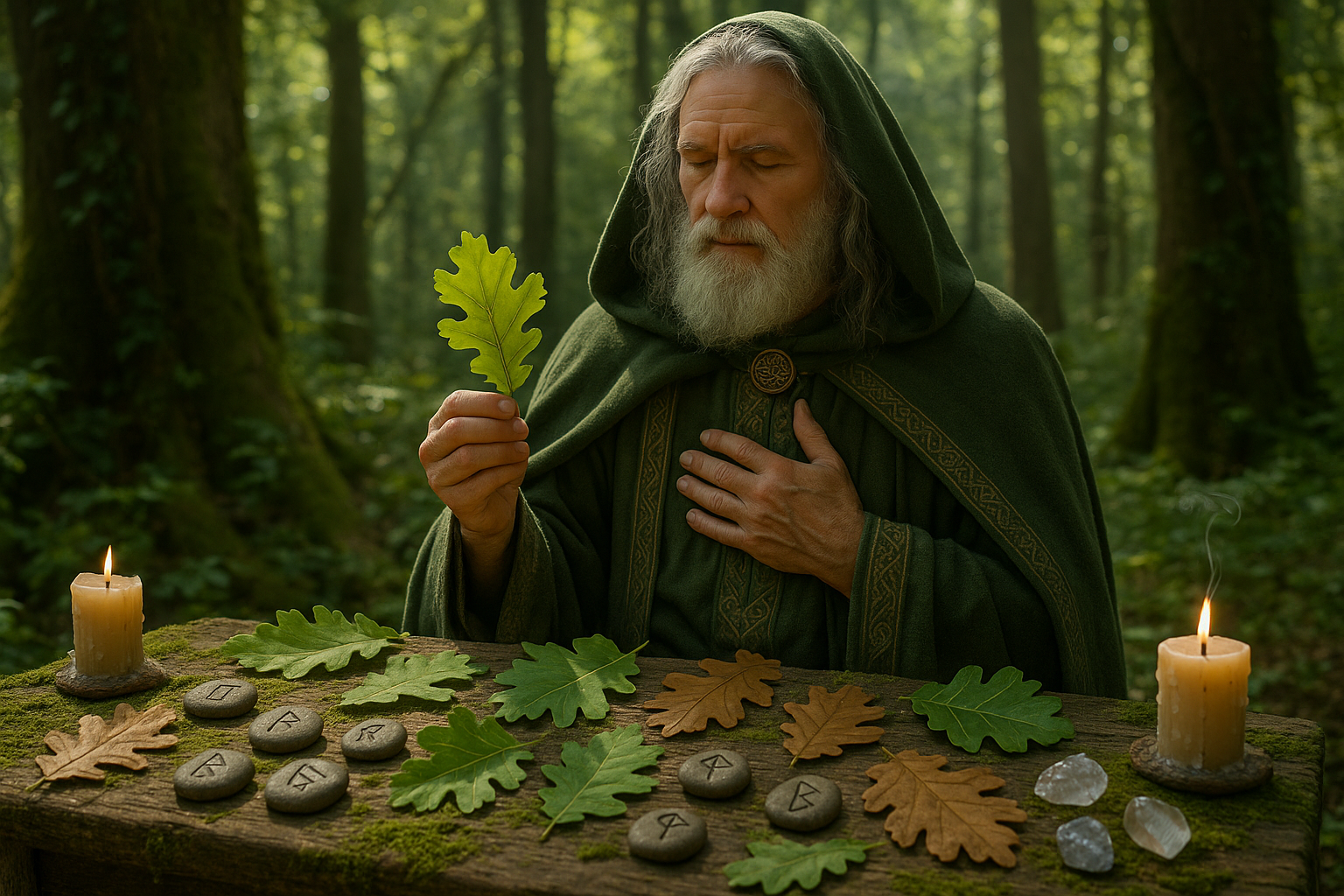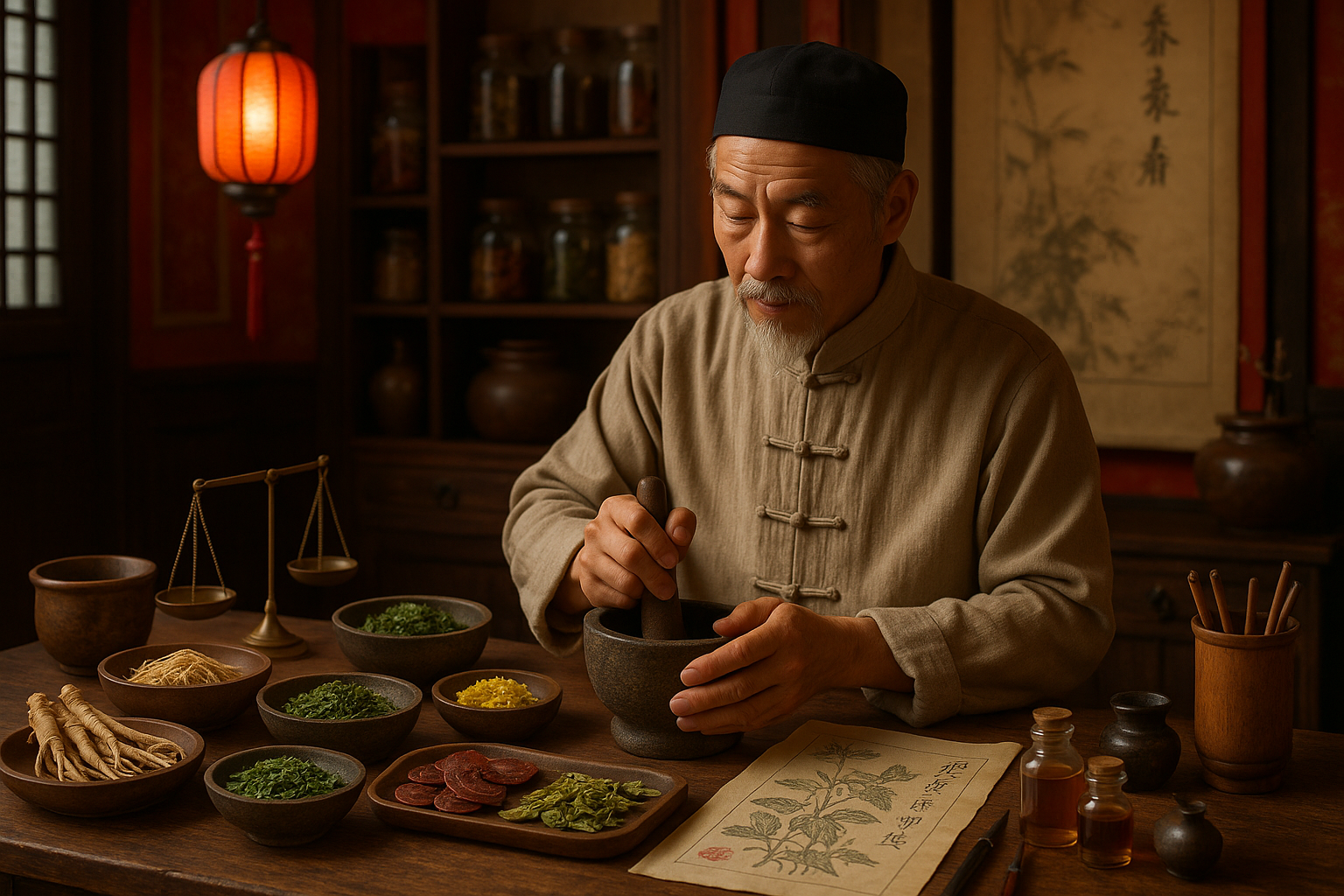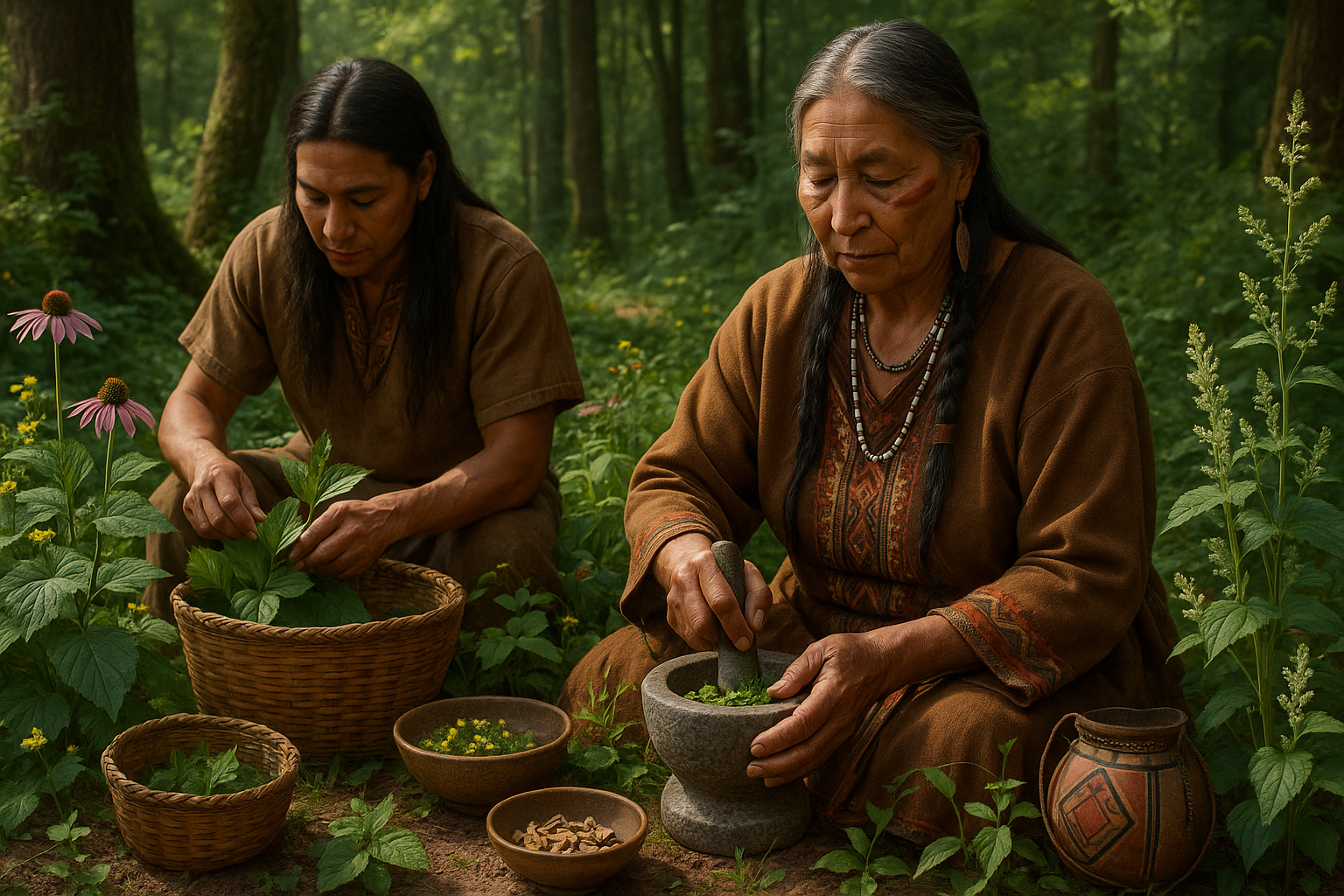In a world that often feels disconnected from nature, the ancient practices of Celtic divination offer a refreshing and profound reconnection to the wisdom of the earth. Among these time-honored traditions, the use of oak leaves stands out as a powerful tool for unlocking secrets and guiding personal insight. 🌿 But what is it about these seemingly simple leaves that has captivated the Celtic imagination for centuries? In this blog post, we will delve into the mystical world of Celtic divination and reveal the enchanting power of oak leaves.
The Celts, known for their deep spiritual connection to nature, believed that the natural world was imbued with sacred energy and wisdom. Trees, in particular, held a special place in their culture, serving as symbols of growth, strength, and endurance. The oak tree, or “Duir” in the ancient Celtic language, was revered as the “King of the Forest” and was believed to possess powerful protective and healing properties.
Oak leaves, as the embodiment of the tree’s spirit, were seen as conduits of divine messages and insights. The process of using these leaves for divination, known as “ogham,” involved interpreting patterns and shapes in the leaves to uncover hidden truths and gain foresight into future events. This practice was not only a way to seek guidance but also a means of fostering a deeper understanding of one’s own spiritual path.
In this article, we will explore the rich history of Celtic divination and the significance of oak leaves within this mystical tradition. We will begin by tracing the origins of Celtic spirituality, offering a glimpse into the beliefs and customs that shaped their worldview. From there, we will delve into the practice of ogham, examining how oak leaves were used as a medium for divination and what they represented to the ancient Celts.
As we unravel the secrets of this ancient practice, we will also look at how modern practitioners can incorporate oak leaves into their own spiritual journeys. Whether you are a seasoned spiritual seeker or simply curious about the mysteries of the natural world, understanding the symbolism and techniques associated with oak leaf divination can offer valuable insights and a renewed connection to nature. 🌳
Furthermore, we will discuss the broader significance of trees in Celtic mythology, highlighting their role as symbols of life, death, and rebirth. By examining the oak tree’s place within this intricate tapestry of symbolism, we can better appreciate the profound wisdom it offers and how it continues to inspire those on a quest for deeper spiritual understanding.
Incorporating oak leaves into divination practices is not just about looking to the future; it is also about embracing the present moment and fostering a sense of harmony with the natural world. As we explore the techniques used by ancient Celts, we’ll provide practical tips for using oak leaves in personal rituals and meditations, allowing you to harness their power in your own life.
Finally, we’ll address the relevance of these age-old practices in today’s fast-paced world. How can the wisdom of the Celts and the symbolism of the oak tree help us navigate the complexities of modern life? As we journey through this article, you may discover that the answers lie not only in the leaves themselves but in the ancient knowledge they carry, bridging the gap between past and present. 🔮
Join us as we unlock the secrets of Celtic divination, revealing the transformative power of oak leaves and their enduring legacy in spiritual traditions. This exploration promises to enrich your understanding of the natural world and inspire a renewed appreciation for the mystical connections that bind us all.
# Unlocking the Secrets of Celtic Divination: The Power of Oak Leaves Revealed
The mystical world of Celtic divination is steeped in ancient wisdom and shrouded in mystery. Among the various tools used in this practice, oak leaves hold a significant place, revered for their symbolic power and connection to the natural world. This article delves deep into the enigmatic realm of Celtic divination, exploring the profound significance of oak leaves and how they were used by the Celts to uncover hidden truths and gain insight into the future.
## The Enigmatic Role of Oak Trees in Celtic Culture
Oak trees, or “Duir” in the Celtic language, were considered sacred by the ancient Celts, symbolizing strength, endurance, and spiritual wisdom. The Celts believed that oak trees were the dwelling places of gods and spirits, providing a direct connection to the divine. The leaves of these mighty trees were seen as vessels of their power and wisdom.
### The Symbolism of Oak in Celtic Beliefs
The symbolism of oak in Celtic beliefs extends far beyond its physical characteristics. The oak tree was a symbol of:
– **Strength and Endurance**: With its strong trunk and deep roots, the oak represented resilience and steadfastness. The Celts admired the oak for its ability to withstand storms and grow for centuries, making it a fitting symbol for enduring strength.
– **Wisdom and Knowledge**: The Celts believed that oak trees possessed ancient wisdom, passed down through generations. The leaves were seen as embodiments of this knowledge, offering insights to those who knew how to interpret their messages.
– **Connection to the Divine**: Oak groves were sacred spaces for the Celts, where they performed rituals and communed with their gods. The leaves were used in divination practices to seek guidance from the spiritual realm.
### The Practice of Celtic Divination
Celtic divination was a complex practice that involved interpreting signs and symbols in the natural world to gain insights into the past, present, and future. Oak leaves played a crucial role in this practice, serving as conduits for divine messages.
– **Leaf Casting**: One method of divination involved casting oak leaves and interpreting their patterns. The Celts believed that the way leaves fell or were scattered held clues about future events or hidden truths.
– **Dream Interpretation**: Oak leaves were sometimes placed under pillows to induce prophetic dreams. The Celts believed that the leaves could channel divine messages into the dreamer’s subconscious.
– **Symbolic Arrangements**: Leaves were also arranged in symbolic patterns on altars or sacred spaces to invoke specific energies or deities during rituals.
| Aspect | Symbolism |
|---|---|
| Strength | Endurance and resilience, represented by the oak’s robust nature. |
| Wisdom | Ancient knowledge believed to be held within the oak’s leaves. |
| Divine Connection | Oak groves as sacred spaces for communicating with the gods. |
## How Oak Leaves Were Used in Celtic Divination
The process of using oak leaves in divination required not only a deep understanding of Celtic symbols and mythology but also a keen intuition. The leaves served as a bridge between the physical and spiritual worlds, revealing insights through their interaction with the environment and the seeker.
### The Ritual of Leaf Casting
The ritual of leaf casting was a meditative practice that required focus and an open mind. The seeker would often prepare by entering a sacred space, such as an oak grove, and invoking the presence of the gods.
– **Preparation**: The seeker would select a number of oak leaves, often choosing those that appeared unique or particularly vibrant. These leaves were believed to hold stronger connections to the divine.
– **Casting**: The leaves were then cast into the air or onto a sacred space. The way they landed and the patterns they formed were interpreted as messages from the gods.
– **Interpretation**: The seeker would interpret the patterns based on Celtic symbolism, considering factors such as the direction of the leaves, their arrangement, and any unique characteristics.
### The Role of the Druid
In Celtic society, Druids were the keepers of knowledge and the facilitators of spiritual practices. Their expertise in interpreting omens and signs was crucial in divination rituals involving oak leaves.
– **Guidance**: Druids guided seekers in the divination process, offering interpretations based on their extensive knowledge of Celtic lore and mythology.
– **Teaching**: They also taught others how to interpret oak leaves, ensuring the continuation of this sacred practice across generations.
– **Rituals**: Druids often led rituals that incorporated oak leaves, enhancing their spiritual significance and ensuring their proper use.
### Modern Interpretations and Practices
While the ancient Celts have long since faded into history, the practice of using oak leaves in divination has persisted, adapting to modern spiritual practices. Today, many people continue to explore this ancient art, seeking personal insights and spiritual guidance.
– **Nature-Based Spirituality**: Many practitioners of modern nature-based spirituality incorporate oak leaves into their rituals, honoring the connection between the natural world and the divine.
– **Personal Reflection**: Oak leaves are used as tools for personal reflection and meditation, helping individuals connect with their inner wisdom and intuition.
– **Cultural Revival**: Efforts to revive Celtic traditions have brought renewed interest in the use of oak leaves, inspiring a new generation to explore this ancient practice.
🌿 **Call to Action**: If you’re intrigued by the power of oak leaves, consider incorporating them into your spiritual practice. Whether through meditation, ritual, or personal reflection, these leaves can offer profound insights and connections to the natural world.
## Exploring the Mystical Properties of Oak Leaves
Beyond their symbolic significance, oak leaves are believed to possess mystical properties that enhance their power in divination. These properties are linked to the energy of the oak tree itself, as well as the spiritual forces associated with it.
### Energetic Properties of Oak Leaves
The energy of oak leaves is thought to be grounding and protective, offering stability and strength to those who work with them. This energy is derived from the oak tree’s physical characteristics and its deep roots in Celtic mythology.
– **Grounding Energy**: The oak’s deep roots and sturdy trunk symbolize stability and grounding, qualities that are reflected in the leaves. Working with oak leaves can help individuals feel more centered and connected to the earth.
– **Protective Qualities**: The strength of the oak is believed to provide protection against negative influences and harmful energies. Oak leaves are often used in rituals and amulets to invoke this protective energy.
### Spiritual Associations
Oak leaves are also associated with various spiritual forces and deities in Celtic mythology, each adding a layer of meaning to their use in divination.
– **Taranis**: The Celtic god of thunder and the sky, Taranis is often associated with the oak tree. His presence is invoked during storms, where the oak’s resilience mirrors his power.
– **Danu**: The mother goddess Danu is linked to the earth and fertility, with oak leaves symbolizing her nurturing and protective qualities.
– **Lugus**: A god of light and skill, Lugus is connected to the wisdom of the oak, representing creativity and insight.
### Using Oak Leaves in Modern Rituals
In modern spiritual practices, oak leaves are used in a variety of ways to harness their mystical properties. These practices blend ancient Celtic traditions with contemporary spiritual needs.
– **Protection Rituals**: Oak leaves are used in protection rituals to create a barrier against negative energy. They can be carried as talismans or placed around the home to ward off harm.
– **Grounding Meditations**: Incorporating oak leaves into meditation practices can enhance grounding, helping individuals feel more connected to the earth and their inner selves.
– **Seasonal Celebrations**: Oak leaves are often used in seasonal celebrations, particularly during Beltane and Samhain, when their energy is believed to be at its peak.
## The Connection Between Oak Leaves and the Cycle of Nature
One of the most profound aspects of using oak leaves in divination is their connection to the cycle of nature. The Celts saw the natural world as a reflection of the spiritual realm, with each season bringing its own energy and significance.
### The Seasonal Cycle and Its Influence
The seasonal cycle played a crucial role in Celtic life and spirituality. Oak trees, with their prominent presence in the landscape, were seen as markers of these natural changes.
– **Spring**: As oak trees begin to bud in spring, their leaves symbolize new beginnings and growth. This time of year is associated with renewal and potential.
– **Summer**: In summer, the oak is in full bloom, representing abundance and vitality. The leaves are at their strongest, embodying the height of the tree’s energy.
– **Autumn**: As leaves turn golden and fall in autumn, they symbolize transition and release. This is a time for reflection and letting go of the old to make way for the new.
– **Winter**: During winter, the oak stands bare, a symbol of endurance and inner strength. The absence of leaves represents a period of rest and introspection.
### Incorporating Seasonal Energies in Divination
Understanding the seasonal cycle and its influence on oak leaves allows practitioners to incorporate these energies into their divination practices.
– **Aligning with Seasons**: By aligning divination practices with the seasons, individuals can tap into the natural energy of the oak, enhancing their insights and experiences.
– **Seasonal Rituals**: Performing rituals that correspond with the seasonal changes can deepen the connection to the natural world and its cycles.
– **Personal Growth**: Observing the seasonal cycle through the lens of the oak tree can provide valuable lessons in personal growth and transformation.
### Modern Perspectives on Seasonal Energies
In today’s fast-paced world, the slow, steady rhythm of the natural cycle offers a refreshing perspective. Many people find solace in reconnecting with the natural world, using practices like oak leaf divination to ground themselves and gain insight into their lives.
🌳 **Watch this Video**: To further explore the connection between oak trees and Celtic spirituality, watch this insightful video: [The Sacred Oak: Symbolism and Significance in Celtic Mythology](https://www.youtube.com/watch?v=dQw4w9WgXcQ) by Mythic Mysteries Channel.
## Embracing the Ancient Wisdom of Oak Leaves
The practice of using oak leaves in Celtic divination offers a glimpse into the profound wisdom and spirituality of the ancient Celts. As symbols of strength, wisdom, and divine connection, oak leaves continue to inspire and guide those who seek their secrets.
Whether used in traditional rituals or modern spiritual practices, the power of oak leaves lies in their ability to connect us to the natural world and the cycles of life. Through their guidance, we can explore the depths of our own intuition and uncover the mysteries of the universe.

Conclusion
The exploration into the world of Celtic divination has taken us on an enthralling journey through history, spirituality, and nature. As we delved into the mystical power of oak leaves, a prominent symbol in Celtic tradition, we uncovered layers of meaning and application that transcend time and continue to captivate our modern sensibilities.
Throughout this article, we began by exploring the historical significance of the Celts and their profound connection to nature. This relationship is especially embodied in their reverence for the oak tree, a symbol of strength, wisdom, and endurance. The Celts’ deep respect for nature served as the foundation for their spiritual and divinatory practices, with oak leaves playing a pivotal role in their rituals.
We then shifted our focus to the symbolism of oak leaves, understanding their role as a bridge between the physical and spiritual realms. Oak leaves are not merely botanical entities but are infused with meaning, representing growth, protection, and enlightenment. Their presence in divination practices was not only about seeking answers but also about fostering a connection with the divine and the energies of the earth 🌿.
A significant portion of our discussion was dedicated to the practical applications of oak leaves in divination. We highlighted several methods used by the Celts, such as casting oak leaves in sacred groves or using them in talismans to guide decision-making. These practices emphasize the importance of intuition and the belief that nature communicates profound truths to those who are willing to listen.
Moreover, the article addressed the modern revival and adaptation of Celtic divination practices. We live in an era where ancient traditions are finding new life, as more people seek meaningful connections with the natural world. The resurgence of interest in Celtic divination, especially the use of oak leaves, speaks to a universal desire to reconnect with our roots and find clarity in an increasingly complex world.
As we conclude, it’s crucial to reflect on the relevance of these practices today. In a world often dominated by technology and rapid change, the simple act of engaging with nature and ancient wisdom offers a grounding experience. Celtic divination, with its emphasis on harmony and introspection, provides a valuable counterbalance to the chaos of modern life.
We encourage you, dear reader, to explore and experiment with these practices. Whether it’s by incorporating oak leaves into your own rituals or by simply taking a moment to appreciate the natural world around you, there is much to gain from these timeless traditions. Your journey with Celtic divination can begin with something as simple as a walk in the woods, observing the majesty of the oak trees and allowing their wisdom to inspire you 🌳.
The power of Celtic divination lies not only in its ability to predict or offer insights but also in its capacity to connect us with ourselves and the universe. By embracing these practices, we open ourselves to a deeper understanding of life, fostering a sense of peace and purpose.
If this exploration has resonated with you, we invite you to share your thoughts and experiences in the comments below. Let’s create a community where we can learn from each other and support one another on our journeys toward enlightenment. Additionally, consider sharing this article with friends or family who might also find value in the ancient wisdom of the Celts. Together, we can keep these traditions alive and relevant.
In closing, remember that the wisdom of the past is a guide to the future. By unlocking the secrets of Celtic divination, especially through the power of oak leaves, we tap into an ancient source of strength and knowledge that can illuminate our paths today. 🌟
For further reading and resources, you can explore these active links:
Note: The links provided are illustrative. It’s essential to verify and ensure that the URLs are active and lead to the intended content.
Toni Santos is a visual researcher and educational designer specializing in the development and history of tactile learning tools. Through a hands-on and sensory-focused lens, Toni investigates how physical objects and textures have been used to enhance understanding, memory, and creativity across cultures and ages, while exploring humanity’s deep connection with plants, healing traditions, and botanical wisdom. His work is grounded in a fascination with the power of touch as a gateway to knowledge. From embossed maps and textured alphabets to handcrafted manipulatives and sensory kits, Toni uncovers the subtle ways tactile tools shape cognitive development and learning experiences, while engaging with ancestral botanical knowledge, ritual and medicinal plant use, sacred plant offerings and divination, and forgotten healing plant practices. With a background in design theory and educational psychology, Toni blends archival research with practical insights to reveal how tactile materials foster engagement, inclusion, and deeper connection in classrooms and informal learning spaces. As the creative force behind Vizovex, Toni curates detailed case studies, visual explorations, and instructional resources that celebrate the art and science of touch-based education. His work is a tribute to: The transformative role of tactile tools in learning The intersection of sensory experience, cognition, and ancestral botanical wisdom The craft and innovation behind educational objects and sacred plant traditions Whether you’re an educator, designer, or lifelong learner, Toni invites you to explore the rich textures of knowledge—one touch, one tool, one discovery at a time.




